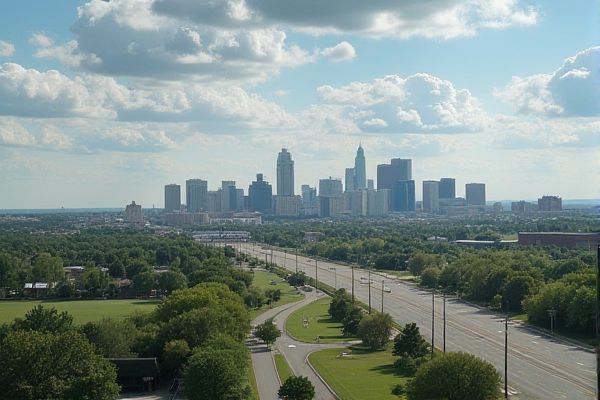
Education system and best schools in South Dakota: Public and Private School Options. South Dakota Department of Education Oversight. K-12 Education Structure. Emphasis on STEM and Vocational Training. High School Graduates' College Readiness. South Dakota Assessment Testing Standards. Largest School District: Sioux Falls. Notable High Schools: Lincoln, Roosevelt. Homeschooling Regulations and Resources. Native American Education Programs.
Public and Private School Options
In South Dakota, the education system offers both public and private school options, with public education being the most prevalent, covering kindergarten to 12th grade, and private schools providing alternative educational pathways. Public schools are divided into elementary, middle, and high school levels, with options for advanced courses like AP and IB. Meanwhile, private schools offer a more personalized education experience. For more detailed information about the school options available, you can visit the Aberdeen School District website.
South Dakota Department of Education Oversight
The South Dakota Department of Education oversees various aspects of education in the state, including accreditation, certification, content standards, and school safety. It also releases annual report cards, develops programs like the South Dakota Sturdy curriculum to enhance life skills, and recognizes excellence through awards such as the National Blue Ribbon Schools.
K-12 Education Structure
The K-12 education structure in South Dakota encompasses compulsory education spanning from Kindergarten to 12th grade, wherein students generally attend either public or private schools. The curriculum, which is established by individual school districts, includes essential subjects such as Science, Mathematics, English, Social Sciences, Physical Education, and Foreign Languages. Additionally, there are opportunities for students to engage in advanced courses like AP and IB, providing a comprehensive learning experience. For more detailed information regarding educational institutions in the region, visit the Aberdeen School District website.
Emphasis on STEM and Vocational Training
In South Dakota, there is a strong emphasis on STEM education, with initiatives like the STEM 2026 vision aiming to provide high-quality, culturally relevant, and innovative STEM teaching from preschool to 12th grade. Universities such as Dakota State University specialize in STEM fields like computer management, cyber security, and related technologies, while top school districts like Brandon Valley and Yankton also focus on providing state-of-the-art technology and advanced educational resources to support STEM and vocational training.
High School Graduates’ College Readiness
In South Dakota, high school graduates' college readiness is evaluated by the ACT College Readiness Benchmarks, with 32% of 2018 graduates meeting all four benchmarks, illustrating significant correlations between advanced coursework and higher benchmark attainment. The state also observes a strong link between family income and academic preparation, with higher-income students more likely to meet College Readiness Benchmarks. This underscores the impact of socioeconomic factors on educational outcomes, emphasizing the need for equitable access to educational resources.
South Dakota Assessment Testing Standards
South Dakota's education system mandates annual summative testing in English Language Arts, Mathematics, and Science for students in grades 3-8 and 11, with additional assessments for writing and English language proficiency. These tests are aligned with state content standards and are part of the state's accountability system. For more detailed information about these assessments, you can visit the South Dakota Department of Education's website.
Largest School District: Sioux Falls
The Sioux Falls School District, one of the largest in South Dakota, enrolls over 24,210 students and operates 44 schools from prekindergarten to 12th grade. The district emphasizes effective curriculum, a nurturing school climate, community engagement, and staff innovation, with a starting teacher salary of $52,233 and a student-teacher ratio of 14.84. For more detailed information about its offerings and initiatives, you can visit the Sioux Falls School District's website.
Notable High Schools: Lincoln, Roosevelt
Lincoln High School in Sioux Falls is ranked as the top public high school in South Dakota, excelling in areas such as college readiness, state assessment proficiency, and graduation rate. Meanwhile, Roosevelt High School, also in Sioux Falls, ranks 14th in the state, highlighting their strong educational performance and programs. For more detailed information on these rankings and their implications, you can visit the article on Best South Dakota High Schools.
Homeschooling Regulations and Resources
To homeschool in South Dakota, parents must file a notification form with the local school district within 30 days of starting, provide education in language arts and mathematics, and follow other specific regulations. Various resources such as the South Dakota Christian Home Educators, national homeschool associations, and local co-ops are available to support homeschooling families.
Native American Education Programs
The Education Program at Oglala Lakota College is nationally recognized for its successful efforts in producing Native American teachers who are enriched with Lakota virtues and cultural values. The program offers comprehensive degrees in Early Childhood, Elementary, and K-12 Lakota Studies Education, all aligning with national and state teaching standards. Meanwhile, in South Dakota, educational leaders are establishing private schools that intricately weave Lakota culture, language, and values into their curricula, aiming to enhance educational outcomes for Native students. This initiative is notably spearheaded by schools like Wakanyeja Tokeyahci School and the newly established academy in Rapid City. The state's Office of Indian Education plays a crucial role in advocating for culturally relevant education by promoting the integration of Oceti Sakowin history and culture across various educational institutions. They work in close collaboration with tribal governments and educational advisory councils, creating a robust network dedicated to this educational transformation.
